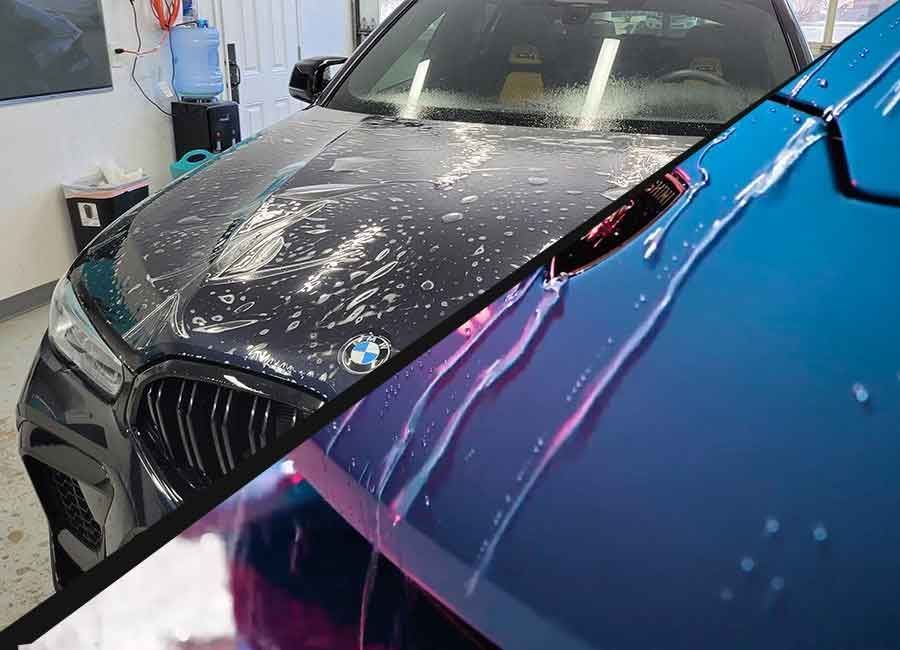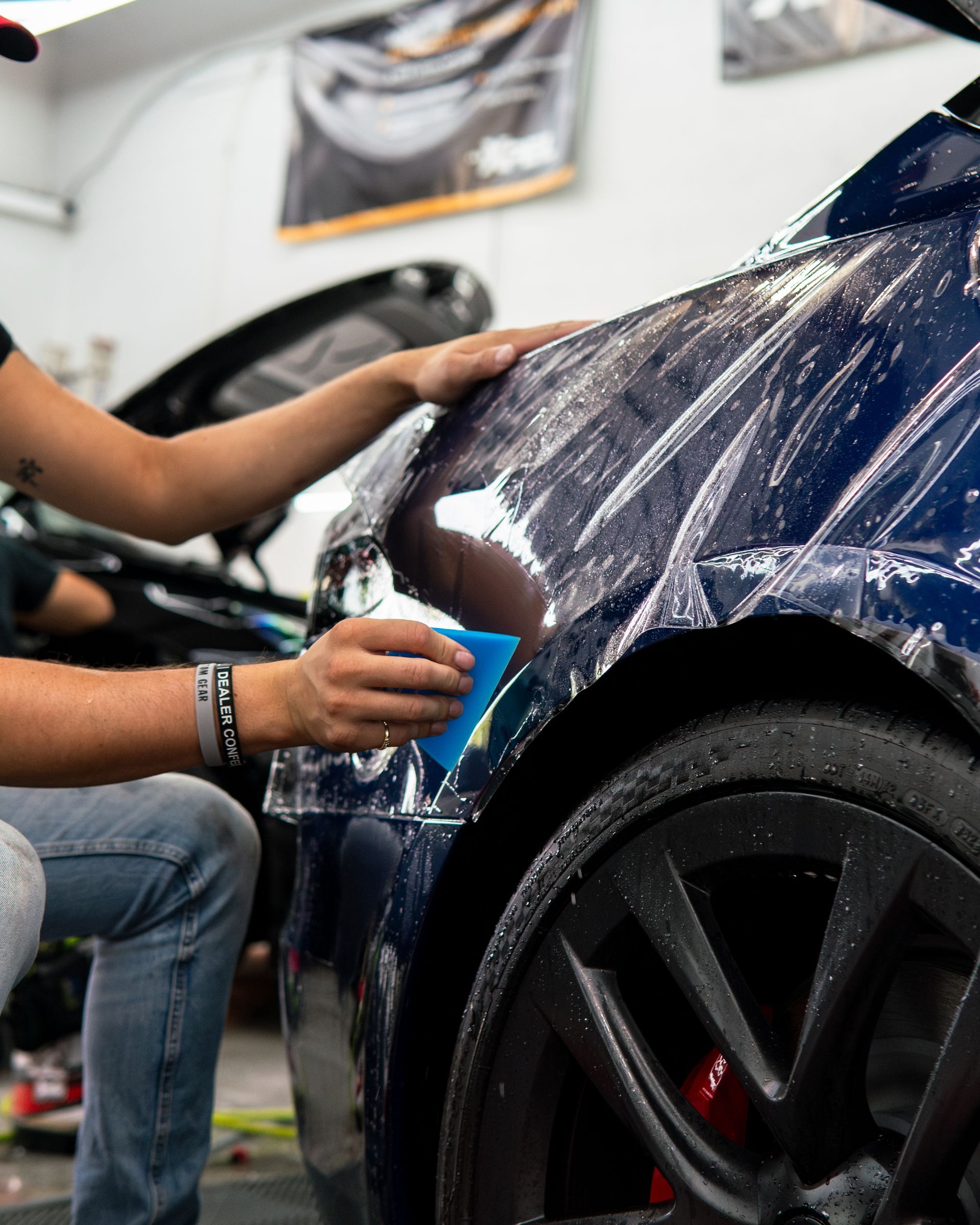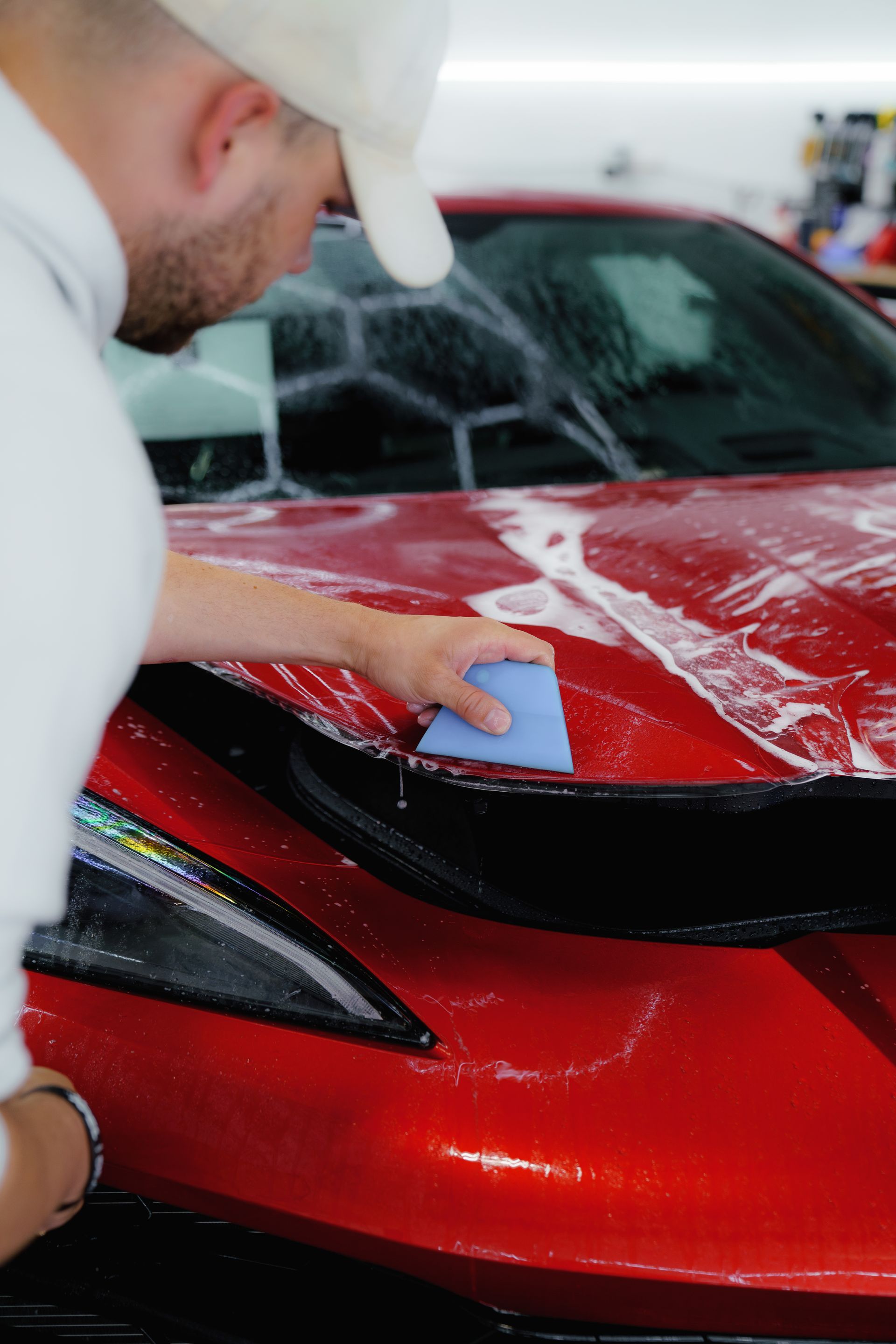Stop! Before you hit that road, think about this scenario: It's a fine Sunday morning, and you're cruising down the highway in your gleaming ride, when—splat! Bird droppings. Or maybe it's an unruly pebble kicked up by the big rig ahead. Imagine the sinking feeling as you later discover that the impact has damaged your car’s sleek paint finish. Fortunately, there is a knight in shining armor to safeguard your car's pristine appearance—Paint Protection Film (PPF). But amidst the myriad options available, how do you choose the right kind for your precious ride? Tailored to those wary of possible damage to their vehicle's exteriors, this blog post will guide you step-by-step in selecting the ideal Paint Protection Film. Dive right in and make sure that every joule of joy your vehicle brings remains untarnished!
When choosing a paint protection film, it's important to consider factors such as durability, level of protection, ease of maintenance, and cost. Additionally, you should select a product that is compatible with your vehicle's make and model. We recommend researching various brands and consulting with a professional installer to determine the best option for your car's needs.
Understanding Paint Protection Film (PPF)
If you are not familiar with
paint protection film (PPF), it is a transparent layer applied to your car's exterior surface that provides an added layer of protection for your vehicle. The PPF protects the paint from various forms of damage such as scratches, dings, and nicks that can happen on the road.
Imagine driving down a gravel road when a group of rocks suddenly kicks back at your car. Without protective film, your car could suffer irreversible damage. You could be facing costly repairs or even have to repaint your car in some cases!
Moreover, unshielded painted surfaces can get stained by bird droppings, contaminants from insects, and tree sap which over time deteriorate the color and devalue vehicles’ worth. However, adding a PPF costs much less than if the vehicle needs to be repainted. Many drivers who have invested in PPF appreciate how it has shielded their cars from daily wear and tear.
To most people, applying protective coating seems futuristic or unreal; similar to adding skin over the skin. But consider how a phone screen protector prevents cracks or scratches on phone screens. Both are transparent layers that protect the surface underneath.
With an understanding of what PPF is and why it matters, let's dive into learning more about the types available out there.
Different Types of PPF
When we talk about PPF types, we're most interested in knowing how it varies in terms of durability, resistance levels towards elements such as UV rays, and hydrophobicity - the ability to repel water spots.
Self-Healing vs Non-Self Healing
PPFs come in two categories: self-healing and non-self-healing films. The former uses advanced technology that allows minor scratches to smooth out repeatedly without leaving permanent damage on the coating. Meanwhile, non-self-healing PPFs lack this feature and might show residue of scratches that do not erase on their own.
Although self-healing films are a bit more expensive compared to non-self-healing products, they offer greater protection to your car’s paint job. In addition, the film offers peace of mind while driving because small scratches and scuffs will not be visible long-term.
Thickness
PPF thickness is measured in "mil," which stands for a thousandth of an inch. PPF options ranging between 6-10 mil thickness levels are common.
Consider what can cause tiny scratches on the clear coat of your vehicle: grit, rocks, and road debris which can cause scratches in the first layer of paint. With thicker PPF, you get much more stone-hitting resistance which is a higher durability value for your vehicle.
There often comes a dispute about increased thickness leading to poorer performance of color matching/clarity in optically clear coats. However, with advancements in technology and new-age equipment applications, quality material producers can now create ultra-thin films without compromising quality or clarity.
Matte and Glossy Finishes
PPFs have two finish variants: matte or glossy. The matte finish produces an ultra-low reflection that mutes out light reflections completely -perfect for drivers who want a discreet appearance for their cars. Comparatively, shiny finishes offer classic mirror-like reflection attributing to the vehicle's showy exterior.
Being popular since these were first produced in Japan during the late '80s; matte finishes complement different vehicles like sports cars or supercars with their majestic tones in subtle shades.
After going through and understanding the different types of PPF available in the market, we must compare them to traditional paint protection coatings to make better purchasing decisions.
PPF vs. Clear Coat: A Comparison
When it comes to protecting your vehicle's paint job, there are a few options available on the market. Two of the most common choices are clear coats and Paint Protection Film (PPF). Each option represents a different approach to paint protection, and both have their advantages and disadvantages.
A clear coat is a layer of transparent paint that is applied over the car's base coat. Its primary purpose is to provide a glossy finish and protect the paint underneath from external elements like UV radiation, dirt, and moisture. Though clear coats do provide some level of protection for the paint job beneath it, it cannot compare to the advanced features found within quality PPFs.
One of the most significant drawbacks to a clear coat is its inability to protect against physical damage like rock chips or scratches. Any forceful impact could easily chip away at the topmost layer of clear coat and potentially cause permanent damage to your vehicle's paint job underneath. That means your car will require more frequent maintenance and may become a victim of unsightly blemishes in its appearance.
PPF, on the other hand, can handle almost anything that can be thrown at it and has been designed with maximum durability in mind. Modern-day PPFs offer self-healing technology which allows minor nicks and scratches caused by everyday road debris or parking incidents to naturally heal over time without any special help.
It is sort of like a basketball game where there are two teams playing; Clear Coat has limited defense capability while PPF has got strong defense built-in that can handle most hits with ease.
In fact, high-end PPFs take things further with advanced features such as hydrophobic coatings that block watermarks from ruining the appearance of your vehicle. These films can also be custom molded to fit snugly around every contour of your car while remaining almost invisible to the naked eye.
Now that we've clearly discussed the disparity between PPFs and Clear Coat protection, it is time to know how to choose the right protection for your vehicle.
Choosing the Right PPF for Your Vehicle
If you have decided that PPF is the best option for protecting your car's paint job, you will still need to make a critical decision: choosing the right type of film. With so many options available in the market, it can be overwhelming trying to figure out what will work best for your vehicle. Here are some critical factors to consider when selecting a PPF product.
Durability and cost play an essential role in choosing the PPF solution that works best for you. High-end films may offer slightly better protective properties than their budget-friendly counterparts. However, this does not mean that you should always buy the most premium PPF option available. In general, consider two scenarios. If you expect only regular driving without too many parking encounters over urban roads that don't have too much debris flying around, then medium-range or budget-friendly options are best suited for you. If however, you're planning long interstate road trips with potentially harm-causing weather or if there may be lots of roadside debris might flying around due to construction work being done along your route, then opt in for a high-end product as it offers superior protection and desirable longevity.
Optically clear coats are vital features of any good quality PPF because they ensure the film doesn't cause any blurry appearances over existing paint jobs and desire flawless finish. Consider opting in buying thin films when deciding on which kind of Paint Protection Film from a range of thicknesses normally 8 mil-22 mil (thicker PPFs serving more cushioning duty). Thin films like 8 to 10 mil are suitable for cars that have delicate clear coats or if you're planning to proceed with high-quality car coating in the later years.
It's also essential to look at the type of vehicle you own when selecting PPF coverage. For instance, if you own a sports car or luxury sedan, then covering vital areas like the front bumper, hood, side mirrors, and fenders may be necessary to protect the sensitive paintwork from harsh UV rays, tough weather conditions, and minor scrapes. On the other hand, for a work truck often driven on rural roads with potential rock chips flying around in every direction as it travels, additional protection may be required to prevent costly maintenance charges down the line.
Another consideration when choosing PPF coverage is picking between a partial vs full-vehicle application plan. Partial car coverage options don't always protect all of your car's body panels as they tend to only focus on areas considered at high risk of getting damaged by external elements. However, obtaining complete PPF coverage can help you avoid future repainting costs caused by unexpected scratches or vandalisms that could happen in unprotected areas.
By considering these factors above before making your first paint protection film selection, you can ensure that your automobile will receive maximum paint protection suitable for its class whilst saving you some money down the line as well.
Evaluating Durability and Cost
When choosing the right paint protection film for your car, it's essential to consider both durability and cost. After all, you want a PPF that will last as long as possible while delivering the most value for your money.
Firstly, let's talk about durability. When evaluating PPFs, the first question to ask is: how strong is it? When it comes to durability, not all PPFs are created equal. Some films might come with a lower price tag but may offer inferior protection and be less durable. Likewise, higher-priced options can provide excellent protection but might not fit within your budget.
I once had a client who opted for a low-cost PPF option, and he was satisfied until he encountered hail during his road trip. The hail damaged the film and ultimately left a permanent mark on his car's surface. It ended up being more expensive in the long run since he had to replace the film sooner than expected.
Lower-priced options generally offer basic coverage and tend to wear out or discolor faster than their higher-priced counterparts. In contrast, more premium PPFs tend to come at a premium price but offer superior resistance against fading, yellowing from UV rays, scratches, dents, and even chemical stains.
One way of evaluating durability is by checking warranties offered by different manufacturers. Warranties can range from one year to ten years or more depending upon the brand and type of PPF. A longer-lasting warranty indicates a stronger film with better resistance properties.
In terms of cost factors affecting your decision, other expenses such as installation fees must also be considered in addition to the actual cost of the paint protection film. Some providers might offer attractive pricing for their services but end up cutting corners during the application, resulting in bubble formation under the film or uneven edges.
Ultimately, it's important to strike the right balance between durability and cost. Opting for the cheapest film option might seem like a money-saving decision, but it can prove to be more expensive in the long run if the film starts peeling or loses its protective properties.
Importance of Optically Clear Coat & Suitability
Another important aspect to consider when choosing PPFs is how well they maintain your car's original appearance. The right PPF should be optically clear and have an unnoticeable effect on your vehicle's paint or metallic finish.
Optically clear coat refers to the clarity of the film - how clear it is. The best PPFs are designed to provide complete transparency to enable a viewer to see through it without any distortion.
A significant advantage of optically clear paint protection films is that they prevent UV rays from penetrating and discoloring your paint job. When left unchecked, the sun's rays can cause your car's color to fade over time, which reduces its value.
Suppose you live in an area with high sun exposure like Arizona or Southern California. In that case, you might need additional concentration on UV ray protection since prolonged exposure can lead to fading and discoloration much quicker than in areas with less sunlight.
In addition, some types of PPFs may not be suitable for certain car finishes or colors. A dark-colored car will require a different type of film than a light-colored one as particles are more visible in darker hues.
It's essential to research and choose manufacturers that offer locally-suitable PPF solutions that match the color and finish of your vehicle. This is critical as it ensures that you get the best results with maximum clarity and ultimate durability while protecting your vehicle from all elements that could affect its value, appearance, and longevity.
With avid advancements in technology, paint protection film products strive to provide premium quality results while being almost invisible once installed on the car’s surface. The more premium films tend to come with a self-healing feature that helps the coating to repair itself when exposed to shallow scratches, hard water spots, and other surface defects.
Overall, while durability and cost are vital considerations when choosing PPFs, don't forget to prioritize optically clear coat and suitability as well.
Installing Your PPF: Considerations
Installing paint protection film on your car can be a great investment to preserve the value of your vehicle. However, it's important to keep in mind that proper installation is crucial to ensuring that the PPF provides adequate protection for your car. Here are some considerations to keep in mind when preparing for the installation of your PPF.
Firstly, you should make sure that the installer you choose is experienced and knowledgeable in installing PPF. Leaving the job to an inexperienced installer could result in poorly installed PPF, which can lead to air bubbles, peeling, and even damage to your vehicle's paint. A reputable installer should be able to walk you through their installation process and provide references from previous satisfied customers.
Secondly, before installing your PPF, make sure your car is clean and free of any dirt or debris. Any particles that get trapped under the film may create bumps and creases that can be visible and damage the finish. Clean your car thoroughly with water and soap before the installation process starts.
During this phase, it’s essential to check if the film size fits perfectly with all of the areas of coverage designed according to your preference.
It’s like how a puzzle piece has to fit within other pieces accurately to form a whole picture; The automotive market has different models with specific features. That's why precision cutting helps form protective layers customized for varying vehicles needing unique protection.
Lastly, decide whether you want full or partial coverage and consider which areas prone to chips or scratches will require added protection. The installer can apply PPF on areas such as bumpers, hood guards, headlights, mirrors, rocker panels, and door edges. Some owners opt for just front-end coverage because it’s where most damages occur during daily driving while others prefer full body coverage to envelop their car entirely.
Now that you have your PPF installed, let's move on to how to maintain it properly.
Maintaining Your Vehicle's PPF
Maintaining your car's PPF is crucial to ensure it provides a long-lasting protective barrier. Here are some tips on keeping your PPF in top condition and extending its lifespan.
Firstly, avoid harsh chemicals when washing your vehicle as they could damage the film’s adhesive layer. Use a mild soap and water solution, and if necessary, use rubbing alcohol or a specialized PPF cleaner to remove any debris that won't come off with soap and water.
Secondly, avoid using a power washer directly on the paint protection film. In high-pressure situations, a power washer can cause damage such as peeling or curling of the edges. Keep the pressure below 2000psi and avoid holding the nozzle too close to the surface.
It’s like cleaning a gentle baby's skin; never use harsh soaps as it could harm their delicate skin texture. Similarly, doing this without proper measures could create stress cracks around edges and seams beyond economical repair.
Lastly, don’t hesitate to consult with your installer if you notice any issues with your PPF or have questions about maintaining it. Your installer should be knowledgeable about how to care for your PPF and provide guidance on any issues that arise.
With these maintenance tips in mind, you can extend the life of your paint protection film while preserving the resale value of your car.
Calling all car owners in Pennsylvania! 🚙
Discover the ultimate protection for your vehicle's paint at Acap Films – the leading expert in car paint protection film installation!
🛡️
Unmatched Paint Protection: Shield your car's exterior from road debris, scratches, and rock chips with our premium car paint protection film. Keep your vehicle looking flawless and maintain its resale value.
✨ Invisible Defense: Our advanced paint protection film is virtually invisible, preserving the beauty of your car's original paint color and finish. Say goodbye to unsightly chips and marks while enjoying a seamless appearance.
🌧️ Weather-Resistant Armor: Pennsylvania's weather can be tough, but our paint protection film can handle it all. Whether it's rain, snow, or UV rays, your car's paint will remain protected and unaffected by the elements.
🔒 Trusted Expertise: Trust your vehicle to our highly skilled professionals who specialize in flawless paint protection film installation. With years of experience and attention to detail, we ensure a seamless and long-lasting application.
💯 Satisfaction Guaranteed: We take pride in our work and prioritize your satisfaction. Rest assured that we stand behind our services, offering you peace of mind and a job well done.
📞 Don't wait! Protect your investment today. Contact Acap Films for the best car paint protection film installation in Pennsylvania.
☎️ Call us now: (484) 241-2038
Give your car the ultimate protection it deserves with Acap Films – the go-to expert in car paint protection film installation. Say goodbye to paint worries and hello to a pristine, flawless finish!





